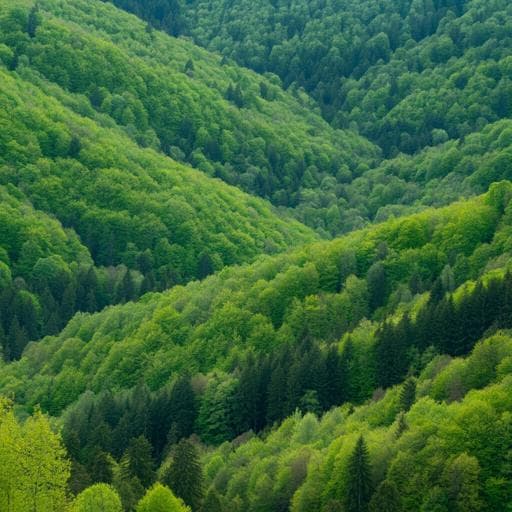
Environmental Studies and Forestry
Reforestation policies around 2000 in southern China led to forest densification and expansion in the 2010s
X. Tong, M. Brandt, et al.
This groundbreaking study by Xiaowei Tong and colleagues uncovers significant changes in forest dynamics in southern China over three decades. Discover how a wave of reforestation post-2000 has led to dense forest formations that are transforming the landscape, even as older forests face fragmentation.
~3 min • Beginner • English
Introduction
The study addresses how and why southern China transitioned from widespread deforestation in the 1980s to extensive forest cover today, and whether recent greening reflects forest expansion, densification, or both. Prior assessments based on coarse-resolution imagery could not resolve the spatial and temporal dynamics of individual forest stands, obscuring the contributions of planting programs versus climate to observed greening. The authors aim to reconstruct southern China’s forestation history at 30 m resolution from 1986 to 2018, quantifying forest age, densification rates, and fragmentation. This fine-scale perspective is important for understanding biodiversity, ecosystem services, carbon stocks, and sequestration potentials in a heterogeneous, plantation-dominated landscape managed at small scales.
Literature Review
The paper situates southern China’s forest transition within broader patterns observed historically in Europe and the USA, and more recently in Vietnam and China since the 1980s. Coarse-resolution satellite studies have reported dramatic greening in recent decades, often attributed to climate or intensified plantations, but without distinguishing densification from expansion. Upscaling from plots and stand growth models provides regional age estimates yet lacks spatial detail. The authors note the challenge of mapping heterogeneous plantation mosaics and small-scale management typical of karst regions, as well as the importance of forest age and composition for biodiversity and carbon estimations. Previous work mapped forest age at broader scales, but high-resolution, temporally deep mapping of stand-level age, densification, and fragmentation remained limited.
Methodology
Concept and data: The study uses the complete Landsat 5/7/8 archive (1986–2020) via Google Earth Engine, generating annual median surface reflectance composites with a 3-year moving median to reduce noise, yielding a study period of 1986–2018. Two vegetation indices (NDVI, NBR) and a 30 m ASTER GDEM (elevation) were included. Cloud and snow/ice pixels were masked via QA bands. Climate variability was summarized using the Palmer Drought Severity Index; biomass was analyzed with ESA CCI GlobBiomass (2018). Training and modeling: A Random Forest regression modeled “forest probability” (fp, 0–100%) indicating similarity to dense forest class. Training data comprised 15,991 dense-forest pixels and 158,728 non-forest pixels across southern China, identified using 2014–2018 national forest inventory data, >10,000 high-resolution GF-1/2 images (2 m / 80 cm), and Google Earth time-lapse to confirm long-term dense forest presence. The model used Landsat bands, NDVI, NBR, and elevation. Accuracy was assessed by bootstrapping with 25% holdout: overall accuracy 98% (Kappa 93%). Independent validation with 167 field plots (2015, Guangxi; canopy cover >10%) showed 88% agreement with mapped dense forests (fp ≥50%). Definitions and time-series processing: Dense forest is defined where fp ≥50% and remains ≥50% through 2018. Emerging forest is fp 20–50%. Forest age is the number of years after first reaching fp ≥50% (and maintaining it) up to 2018. The densification rate is the mean annual increase in fp between 20% and 50% (probability % per year). Time series were smoothed by polynomial fitting in addition to annual and 3-year medians to suppress short-term noise while retaining multi-year disturbances (e.g., harvest). Plantation year is estimated as the first year fp crosses 20% and then increases continuously to 50%; the authors caution this is a proxy for stand emergence, not necessarily the exact planting date. Short-rotation plantations that do not reach or maintain fp ≥50% (e.g., some Eucalyptus, rubber) are typically excluded. Fragmentation analysis: Annual binary dense forest maps were segmented using MSPA to classify core forest (≥3×3 neighborhood of dense forest at 30 m, minimum ~0.9 ha) versus non-core (edges, islands, bridges). Patch metrics (core patch size and count) and core/non-core ratios were computed annually. Spatial and elevational analyses examined the diffusion from mountains to valleys and compared densification across elevation bands.
Key Findings
- Forest area growth: Dense forest extent increased from 249,414 km² (1986) to 491,496 km² (2003) and 978,954 km² (2018), raising southern China’s dense forest fraction from 9% to 35%. Two major expansion waves occurred: mid-1990s and around 2010; the first was followed by minor contractions, while no comparable contraction has yet followed the second. - Age structure: Only 225,890 km² (23%) of current forests predate 1986 and remained uncut through 2018; just 10,326 km² of these older dense forests were lost over three decades. About 32% of current dense forests reached their dense state within the last 10 years. New dense forests often expanded from remnants existing in 1986. - Downhill expansion: Old forests in the 1980s were fragmented on mountain tops; forests expanded downhill by 729,540 km², progressively occupying valleys and flatter terrain. - Densification dynamics: Forests that reached dense state within the past decade did so almost twice as fast as older cohorts, indicating accelerated pre-dense growth rates. This pattern is consistent across elevations (>500 m and <500 m) and suggests a shift toward faster-growing, likely lower-diversity plantations established after ~2000. Favorable climate conditions around 2010–2013 may have contributed. - Post-dense development: After reaching fp ≥50%, forests continued to increase in fp, with younger dense forests converging toward the fp levels of older dense forests by 2018. Biomass density (2018) increases with years since dense state up to ~15 years; dense forests aged 16–32 years show similar biomass, while pre-1986 dense forests have notably higher biomass. - Fragmentation reversal and connectivity: In 1986, core forests covered 93,197 km² and 63% of forests were non-core (including 36,003 km² as isolated 30×30 m islands). Core forests increased massively in the past decade, rising by 517% (an additional 482,092 km²); 84% of 2018 core forests are new (<3 decades). Younger (<10 years dense) forests are rarely core. Average core patch size grew from 0.03 km² (1986) to 0.07 km² (2018), and core patch numbers rose from ~3 million to >7 million. In 2018, 403,664 km² (41% of forest) remained non-core. - Policy linkage: The surge of dense forest around 2010 largely reflects trees planted around 2000 that matured to dense canopies about a decade later, rather than a primary response to policy changes circa 2010.
Discussion
The high-resolution, time-resolved mapping demonstrates that southern China’s prominent greening around 2010 was primarily the maturation of plantations established around 2000, making the densification wave visible in satellite observations as stands crossed the dense threshold. Thus, both expansion (early 2000s plantings) and subsequent densification (over ~a decade) jointly produced the observed greening, rather than a sudden intensification of forestation around 2010 alone. The spatial diffusion from mountainous remnants into valleys indicates a reversal of common global patterns where human activity confines forests to rugged terrain. Connectivity increased substantially as scattered patches coalesced into larger core forests, buffering older forests and potentially reducing logging pressure on them. However, the rapid and homogeneous densification rates point to fast-growing, likely lower-diversity plantations, raising concerns for long-term resilience, biodiversity, and stability of the carbon sink under climate stressors. Declining rural pressure may have facilitated conservation of older forests, while favorable climate periods also supported faster growth. Overall, the findings clarify the mechanisms behind forest return and connectivity gains and inform assessments of carbon sequestration and habitat change.
Conclusion
This study delivers annual 30 m maps of forest probability, age, densification rate, and fragmentation for southern China (1986–2018), revealing a quadrupling of dense forest area and a six-fold increase in core forests. The marked greening around 2010 is traced to plantations initiated around 2000 that reached dense canopy about a decade later, with densification rates nearly doubling for recent cohorts relative to earlier ones and occurring across elevations. Forest expansion reversed fragmentation by connecting previously isolated patches, while older dense forests experienced limited loss and increased buffering. The dataset refines understanding of carbon stock trajectories and ecosystem connectivity in a highly managed landscape. Future research should: integrate species composition and management data to assess biodiversity and resilience; monitor the longevity and stability of fast-growing plantations under climate extremes; better capture short-rotation and young stands; and evaluate socio-economic drivers shaping spatial patterns of forest return.
Limitations
- Forest definition focuses on closed-canopy stands (fp ≥50%) persisting to 2018, likely underestimating the extent of young or frequently harvested plantations (e.g., short-rotation Eucalyptus, rubber) that do not reach or maintain the threshold. - Forest age reflects years since reaching the dense state, not true planting dates; the “plantation year” proxy (fp crossing 20%) may precede visible canopy formation and is more uncertain. - Time-series smoothing (annual medians, 3-year moving median, polynomial fitting) reduces noise but may dampen short-term disturbances and timing precision near thresholds. - Model uncertainty cannot be inferred directly from fp outputs; while overall accuracy is high and field validation supports dense forest detection, class-specific error rates may vary spatially. - Persistent cloudiness constrained the time series to 1986–2018 and required compositing, potentially affecting temporal detail. - Results pertain to southern China and may not generalize to areas with different management regimes, species, or disturbance histories.
Related Publications
Explore these studies to deepen your understanding of the subject.







